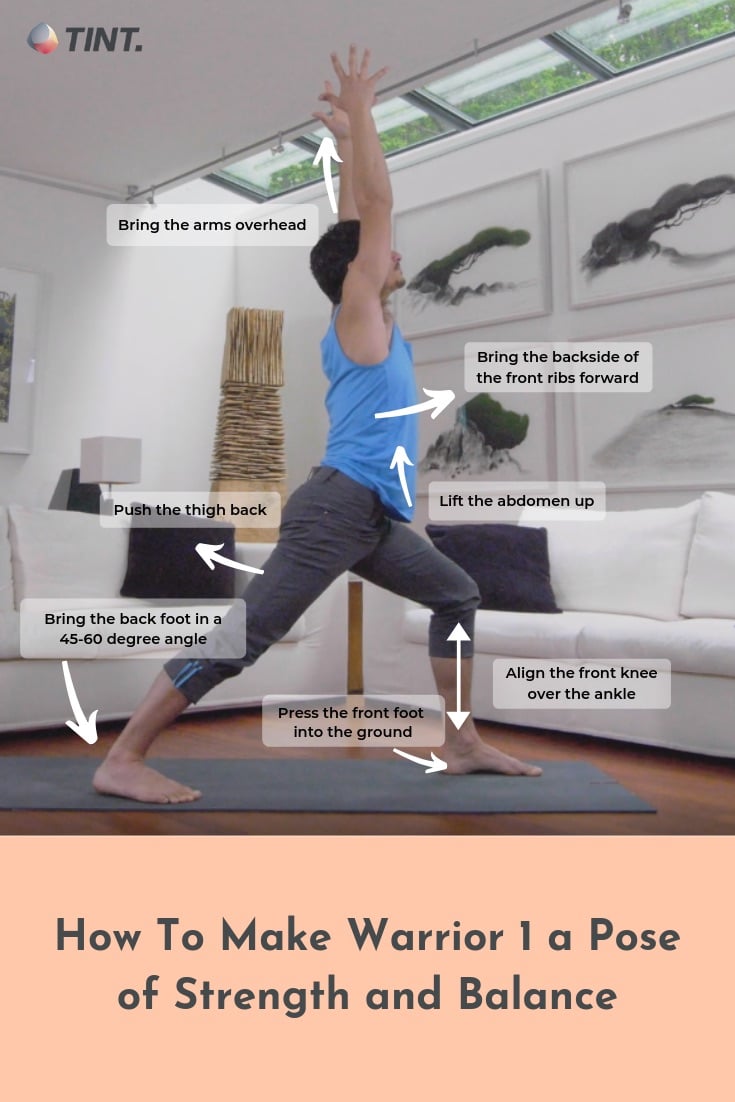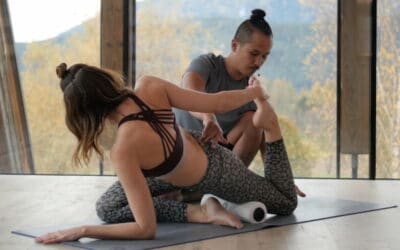Warrior 1 is a yoga position called Virabhadrasana 1 in Sanskrit and is the first variation of a series of three standing asanas referred to as warrior poses: Warrior 1, Warrior 2, and Warrior 3. Isn’t it strange that yoga poses are named after a warrior since non-violence (ahimsa) is one of the basic principles of yoga?
However, the poses’ name does not refer to an actual person fighting in a battlefield, it’s rather supposed to remind practitioners of yoga to uphold their spiritual warrior who bravely battles with the universal enemy and ultimate source of all human suffering: self-ignorance.
Consider Warrior 1 a yoga position that is a symbol of focus and strength to carry you through the most challenging moments of the practice.

Consider Warrior 1 a yoga position of focus and strength. Photograph on canva.
Table of Contents
1. How Do You Get Into Warrior 1 Pose?
- Start from Mountain pose (Tadasana) and step one foot back into a high-lunge position and bring the foot a little bit further out toward the outer edge of the mat.
- Put the heel of the back leg down and angle your foot to a 45 – 60 degree angle. Letting the toes point fairly forward makes this asana more accessible. If the toes point outward, it’s far more challenging to square the hip. Beginners are recommended to choose a shorter stance since this will provide more stability in the legs.
- Press the front heel firmly into the ground so that you feel the underside of your buttocks engage.
- Try to square the pelvis as much as possible with the front edge of the yoga mat. This means that both hip bones should point forward to the extent possible.
- Note that attempting to angle both hips towards the front is ideal, but not a must. You should especially avoid this if you feel any pain in the hips, the knees or the lower back. In this case, you can lift your back heel up and come into a high-lunge position instead or keep your feet hip-width distance apart as if on separate train tracks in order to keep your hips facing forward.
- As the back hip bone turns forward, press the head of the back thigh away to ground the back heel and lift from the inner arch. Keep the back leg engaged throughout this pose and let it be your anchor.
- With the back heel firmly rooted into the floor, bend the front knee so that it aligned over the ankle of the front foot. This means that the shin is perpendicular to the floor.
- Bring the backside of the front ribs forward while drawing the abdomen up and lifting the ribcage away from the pelvis.
- With this lift in the chest, take the arms out and up over your head with the palms facing each other. Reach actively through the pinkie-finger sides of the hands toward the ceiling.
- Keep your head in a neutral position and gaze forward. You can also tilt your head back and look up at your thumbs.

Learn proper alignment in Warrior 1 with Matt Giordano’s Essentials of Yoga on TINT.
2. What Is Your Body Doing In Warrior 1?
2.1. What Are the Joints Doing?
Like in all warrior poses, the spine is extended in Warrior 1, with a slight rotation in the thoracic spine for the chest to face forward. The pelvis is level.
In the upper limbs, we see that the scapulae are abducted and upwardly rotated. The shoulders are abducted as well and externally rotated and the elbows are slightly flexed.
When it comes to the lower limbs, it is necessary to examine the front leg and the back leg separately since they are in different positions.
The front leg performs the following joint actions:
- nutation of the sacroiliac joint (i.e. the top of the sacrum tips forward and the bottom tilts back)
- flexion of the hip
- flexion of the knee
- dorsiflexion of the ankle.
Looking at the back leg, we see:
- counternutation of the sacroiliac joint (i.e. the top of the sacrum tips backward and the bottom moves forward)
- extension and adduction of the hip
- dorsiflexion of the ankle
- supination of the foot at the heel and pronation at the forefoot.

Warrior 1 can also be practiced as a strong backbend. Photograph on unsplash.
2.2. Which Muscles Are Engaged?
The main players to extend the spine in Warrior 2 are the spinal extensors while the internal oblique of the front leg side and the external oblique of the back leg side effect the forward rotation of the chest.
In addition, the psoas minor and the abdominal muscles contract eccentrically to prevent hyperextension of the lumbar spine. There is also a variety of neck muscles contracting eccentrically to support the weight of the head.
In the upper limbs, the serratus anterior contracts to abduct and upwardly rotate the scapulae. The rotator cuff and the biceps brachii and middle deltoid stabilize and abduct the shoulder joint.
Let’s look at the muscles engaged in the front leg:
- The gracilis and the adductor longus and brevis contract concentrically to prevent the knee from abducting at the hip.
- The gluteus maximus, the hamstrings and the intrinsic and extrinsic muscles of the foot contract eccentrically to effect the flexion of the hip and knee and the dorsiflexion of the ankle without collapsing into gravity.
- The gluteus medius and minimus as well as the piriformis help to level and center the pelvis and to maintain balance. Note that the muscles need to be more active when the stance is narrower.
In the back leg, the following muscular actions are relevant:
- The hamstrings, the gluteus medius and maximus as well as the adductor magnus extend the hip.
- The articularis genu and vastii extend the knee.
- The intrinsic muscles of the foot help to maintain the arches of the foot without disturbing the dorsiflexion of the ankle.
- The peroneus muscles are in eccentric contraction in order to allow the outer ankle to lengthen without letting the inner knee or foot collapse.
Note that in Warrior 1, as well as in other standing lunging poses, the body weight effects the flexion of the knee and hip of the front leg. This means that the muscles of the front leg are eccentrically contracting, i.e. they are active and lengthen in order to prevent flexing too much.
Also the abductors in the front leg need to lengthen to level the pelvis and orient it to the front leg and to maintain balance. If they contract, they can pull the front knee too far to the side or bring the pelvis out of alignment.
If you need a break from all the theory now, hop on your yoga mat and put your newly gained knowledge into practice. Let Matt Giordano guide you through Warrior 1 in his Essentials of Yoga on TINT.
Let Matt Giordano guide you through Warrior 1 in his Essentials of Yoga on TINT.
3. How Can You Make Warrior 1 a More Accessible Yoga Position?
If you feel unstable in Warrior 1 pose, or if you simply want to modify this yoga position, let your back knee rest on the ground for Mini Warrior (Anjaneyasana). This pose is easier accessible especially if practiced in the context of Sun Salutations (Surya Namaskar).
You basically get into Mini Warrior in the same way as you move into Warrior 1 pose. So you step back from Mountain pose (Tadasana), but instead of keeping your back leg straight, you place your knee on the ground.
Tuck your toes instead of letting the foot rest on the ground. This will help you to engage your leg muscles. Pull the front heel and the back knee towards each other and square your hips. Create space in your lower back.
You will lose this space in the lumbar spine if the back foot is pointed and rests on the floor. This also results in a slight outward rotation of your thigh and, thus, a little twist in your spine.
Once you have set your stable foundation, raise your arms up overhead and lengthen your side body. Pull your pubic bone up to create even more length. Lift your shoulders up to your ears and move your armpits back without pulling them down.
Note that Mini Warrior is a backbend, i.e. you need inward rotation in your back thigh and outward rotation in your arms to open your shoulders. To activate your back muscles in this backbend, bring your arms behind your head and interlace your fingers. Now, push your head against your fingers and lift your chest up.
Straighten your arms again and bring your shoulders up and back. Also, lift your chin a little bit so that you don’t have any wrinkles on your neck. This will avoid compression to your windpipe.
Although this yoga position is called Mini Warrior, it can be quite intense. It will allow you to experience a deeper – and more stable – backbend if this is not accessible to you in Warrior 1 pose.

Learn Mini Warrior as a variation of Warrior 1 pose with our Inside Yoga Alignment.
If you’re looking for a quick reference to avoid misalignment in other yoga poses as well, have a look at our free yoga asana ebook. It will give you a sound understanding of the alignment principles of some of the most common asanas and will make a huge difference to your yoga practice.
4. How Do You Build Warrior 1 Into Your Yoga Practice?
Warrior 1 is a yoga position that is often used as a warm-up pose in yoga classes or as part of the Sun Salutation series (Surya Namaskar), especially Sun Salutation B.
Apart from Sun Salutations, you can build up to Warrior 1 from High Lunge, Mountain pose (Tadasana) or Warrior 2, or maybe even build a sequence of one or several of these poses.
While it also is a good standing pose in preparation for deeper backbends, Virabhadrasana I is a great posture to transition into more complex standing poses such as Prayer Twist or Warrior 3 (Virabhadrasana 3).

Transition into Warrior 3 from Warrior 1. Photograph by Wesley Tingey on unsplash.
To bring some variety to your Warrior 1 pose, perform it with the arms in various positions. You can, for example, bring the hands together in prayer position (Anjali Mudra) in front of your chest or simply keep the hands on the knees or the hips.
With your hands resting on your hips, bend the front knee and swing your arms behind your torso and clasp your hands. Stretch your hands away from the back and lift your chest up.
From here, you can move further into Humble Warrior (Baddha Virabhadrasana) by bringing your upper body down on the inside of your bent leg while keeping hands clasped behind you and the arms straight and lifted.
To come out of the pose, release your hands and bring your arms up over your head to pull your torso up and straight the front leg.

Try Humble Warrior as a variation of Warrior 1 pose with Matt Giordano’s Essentials of Yoga.
Apart from having the arms over the head in a H-shape position with the palms facing each other, you can bring the palms together crossing the thumbs, or interlace the fingers letting the index fingers point up. Another variation would be to reach the arms out to the sides or hold on to opposite elbows above the head.
The truth is – like with any warrior pose – there’s no one-size-fits-all way to perform Warrior 1. However, you might find that some of the alignment tips, explanations and modifications provided in this article will help you or your students gain more confidence in this asana. If you’re looking for further guidance on proper alignment in other yoga poses as well, check out our free yoga asana ebook, which summarizes the alignment essentials of some of the most common yoga poses so you can use it as a quick reference for your yoga classes.
5. What Are the Benefits of Warrior 1 Pose?
Practicing Warrior 1 will strengthen the shoulder muscles and the spine as well as the legs and feet while at the same time increasing the flexibility in these body parts. As it works and engages the whole body, it’s a yoga pose that will increase your core strength and improve focus, balance and stability.
Virabhadrasana 1 is a whole-body stretch from your neck, shoulders and arms to your belly and groins, and even down to the legs and ankles. Since it opens your hips, chest and lungs, this asanaencourages good circulation and respiration and, as a result,energizes the entire body.
Warrior poses in general are essential for building strength and stamina in your yoga practice. They give you confidence as they help you build strength in the entire lower body and core.
Since Warrior 1 is a gentle backbend it’s a great yoga pose for stretching the entire front body while strengthening the legs and glutes as well as the core and upper body muscles.
Note that practicing this asana is contraindicated for practitioners with recent or chronic injuries to either the hips, knees, back or shoulders.
If you’re looking for inspiration on how to incorporate Virabhadranasa 1 and other standing poses to gain a strong and stable foundation, check out Faith Hunter’s Chakra Awakening Body & Soul program on TINT. This program is designed to ignite the physical body and help you connect to your natural way of aligning through strength and stability.
Practice Warrior 1 pose with Faith Hunter in her Chakra Awakening program on TINT





